NordVPN
NordVPN is a Panama-registered service that provides VPN products for more than a million customers.
The company sells itself very much on features, and it's easy to see why. The VPN offers 4,900+ servers in 62 countries. You get Windows, Mac, iOS, Android, Linux and other apps. And with support for six simultaneous connections, you can probably use all your devices at once.
- Want to try NordVPN? Check out the website here
There are all the technical features you'd expect, including OpenVPN support for strong encryption and high performance, a kill switch and DNS leak protection to keep your identity safe. Not-so-common extras include double data encryption and Onion support for extra security. P2P support is a major plus, and a clear no logging policy and NordVPN's Panama registration give above-average reassurance that your internet activities won't be visible to anyone else.
If you're intimidated by this feature overload, or just run into some unexpected problems, NordVPN's 24/7 support is on hand to point you in the right direction. Prices are fair, and if you're not quite convinced that this is the VPN for you, a 3-day trial, no payment details required, allows you to sample the service for yourself.
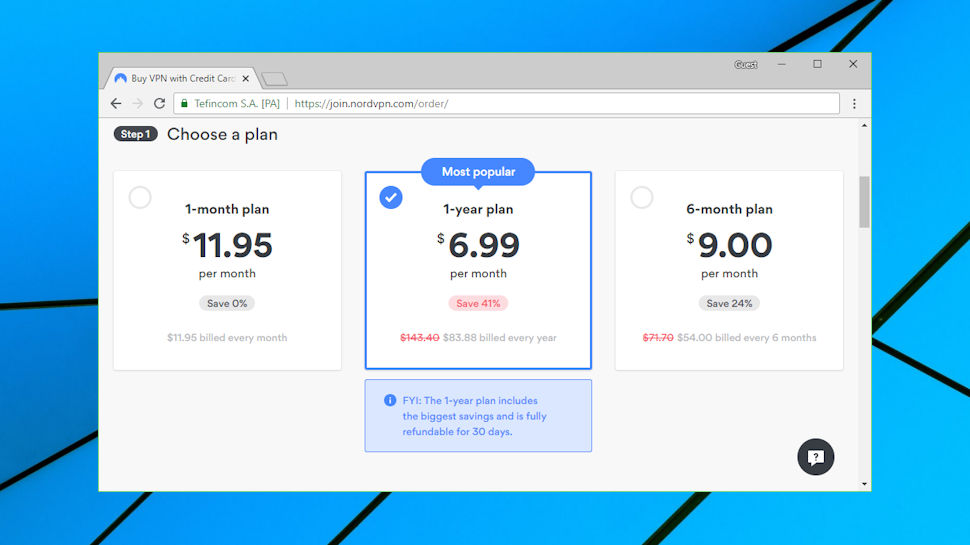
Plans and pricing
NordVPN has a clear and simple pricing structure with three straightforward plans.
You can opt to pay $11.95 (£9.19) a month with the monthly plan, an effective $9 (£6.92) a month billed every six months, dropping to $6.99 (£5.38) a month (a chunky 41% discount) if you pay for a year up-front. These are all decent mid-range prices which fit within the range we'd expect for a quality VPN. ExpressVPN is more expensive at $8.32 (£6.40) a month for the annual plan, for instance, while VyprVPN is fractionally cheaper at £4.79 ($6.23).
During our review, NordVPN was also offering a special deal priced at only $3.99 (£2.85) if you pay for two years up-front. That looks like a very good price to us.
Each plan is clearly described, with none of the sneaky marketing tricks you'll often find online. There's no misleading headline rate, no discounts which disappear on renewal, no need to sign up for years to get what you're promised. The website simply tells you the effective monthly rate, the billing frequency and the total you'll pay each time, ensuring you understand the deal before you click 'Buy'.
The positive impression continued as we worked through the signup process. There's no need to hand over all your personal information, as NordVPN only wants your email address. And even NordVPN's payment options are better than most, with support for cards, PayPal, Bitcoin and other cryptocurrencies (via CoinPayments), and assorted other systems (Alipay, WebMoney, Yandex and more).
If you're not quite sure whether NordVPN is right for you, the company offers a free 3-day trial, no payment details required. This isn't easy to spot from the website, but you can find it by pointing your browser at free.nordvpn.com.
Once you do sign up, you're also protected by NordVPN's 30-day money-back guarantee. Forget the sneaky clauses you might have seen with other services, where for instance you won't get your money back if you've logged on 'too many' times, or transferred 'too much' data. We found no attempt to catch you out, so you're able to use the service as much as you like, and if you're unhappy, cancel in the first 30 days and you'll get a full refund.

Privacy
The privacy value of all VPNs starts with the support for encryption technologies, and NordVPN scores well with its AES-256-CBC support using a 2048-bit Diffie-Hellman key. This isn't quite up to the top-of-the range standards of RSA, but only encryption geeks will even notice, and it's more than enough encryption power for most situations.
NordVPN wins bonus points elsewhere for its strong IKev2/IPsec support. This gets you AES-256-GCM for encryption, and supports perfect forward secrecy to regularly change keys (this time using 3072-bit Diffie-Hellman), ensuring that even if an attacker manages to penetrate one session, they'll be locked out of the next one. It's an excellent system which is now NordVPN's default for Mac and iOS, and is also available in some of the other clients (including Windows).
Once you're connected, NordVPN has other tricks it can employ to improve your privacy. These include Onion over VPN, which routes your traffic first through NordVPN's own network, then directs it over the Onion network and on to its final destination.
This double layer of obfuscation will slow the service down, but also makes it extremely difficult for anyone to trace an action back to you. Best of all, you don't have to know or understand anything at all about Onion to make this work. There's nothing to install or set up, just use your client to connect to one of NordVPN's specialist Onion over VPN routers and the system will handle everything automatically.
NordVPN also offers a Double VPN system where your traffic goes to one VPN server, then is re-encrypted and sent to a second NordVPN server, before being sent to its destination. This isn't going to be necessary, or even useful for most people, but it's there if you can find a reason to use it, and the technology doesn't slow you down as much as you might expect. A quick check on our review system showed download speeds of 65Mbps when not connected, 48Mbps when using Double VPN.
However you're connected to NordVPN, its kill switches work to prevent any data leaks if the VPN connection drops. NordVPN stands out here for having two kill switches. A general internet switch blocks all net access when you're not connected to the VPN (this can be easily turned off if it's inconvenient), while an app kill switch kills specified applications if the connection goes down.
NordVPN claims the service blocks DNS leaks, too, and our checks with dnsleaktest.com, ipleak.net and other sites confirmed this. Our DNS address was always the same as our IP address, with no DNS, WebRTC or other leaks detected.
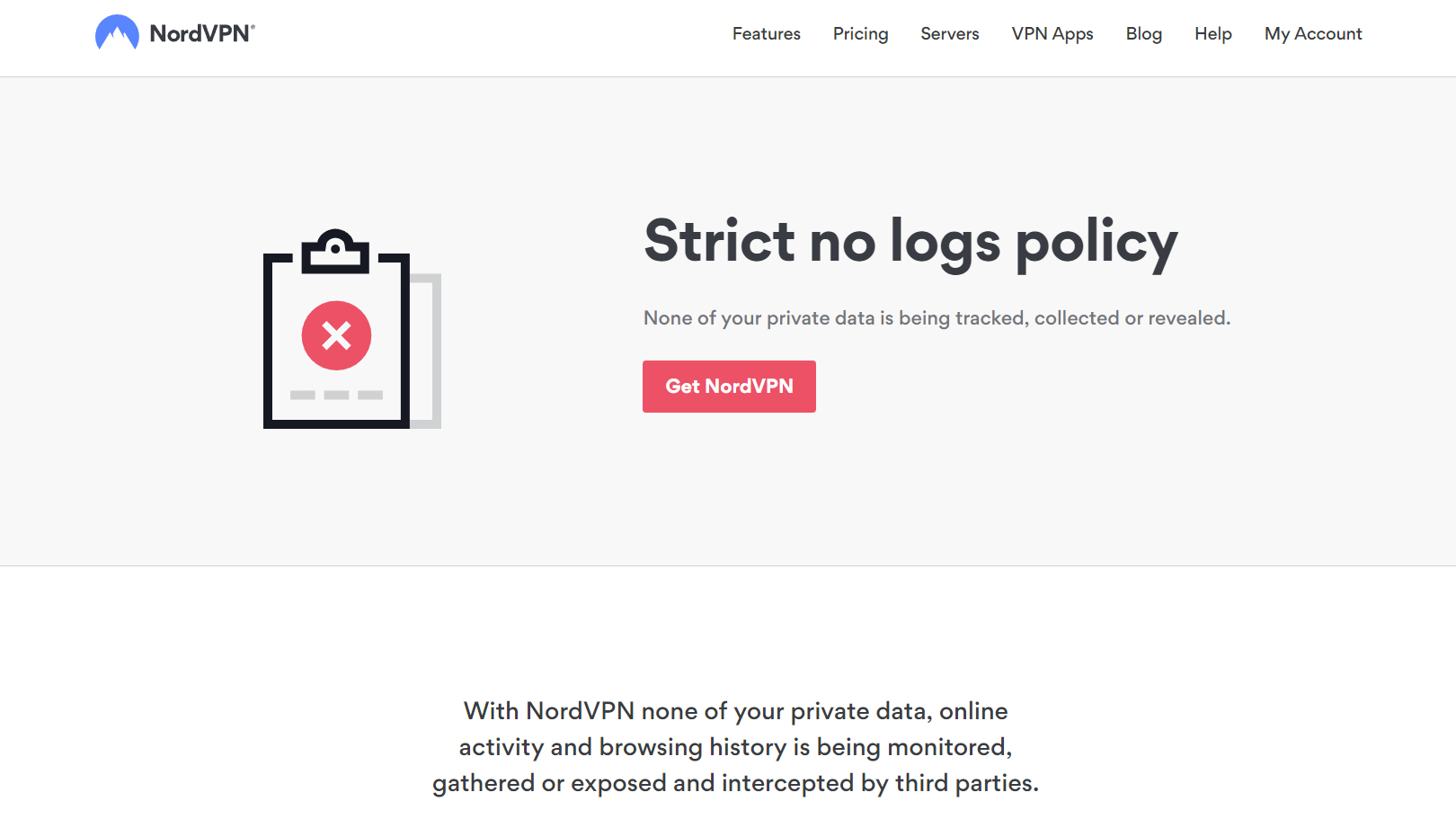
Logging
NordVPN claims to have a strict 'no logs' policy. Most VPNs say much the same, but the company defines this more clearly than most, saying:
"NordVPN strictly keeps no logs of your activity online. That means we do not track the time or duration of any online session, and neither do we keep logs of IP addresses or servers used, websites visited or files downloaded."
That covers not only general logging of your internet activities, but also session logging details such as recording your incoming IP address when you connect to the service, and the IP you're allocated. (When other VPNs say 'no logging', they often carry out some form of session logging, so it's good to see NordVPN rule it out).
What VPN providers say on the front page of the website isn't always what you'll read in the small print, so it always pays to check out the privacy policy and any other small print.
In this case, though, we found absolutely no privacy-related surprises, at all. The company does keep some additional information about you, but there's nothing you wouldn't have guessed already (email address, payment information, messages you might send to customer service, cookies on the website). And you could minimize even this level of disclosure by, say, using an email for VPN signups alone, and paying via Bitcoin.
Recent news stories have suggested this isn't the full story, with allegations that NordVPN is owned by a data mining company, and uses Hola-type technology to resell user's bandwidth. We'll keep an eye on this to see where it goes, but right now we don't see the slightest bit of evidence to back up any of this, so we're not going to take account of it in our review.
Even better, NordVPN has announced a fight-back of its own, stating that it is "hiring one of the largest professional service firms in the world to run an independent audit and verify our 'no logs' claim." Sounds like a very good idea to us. If this works out as we expect, it could leave NordVPN with more evidence to support its no logging claims than any other VPN provider.
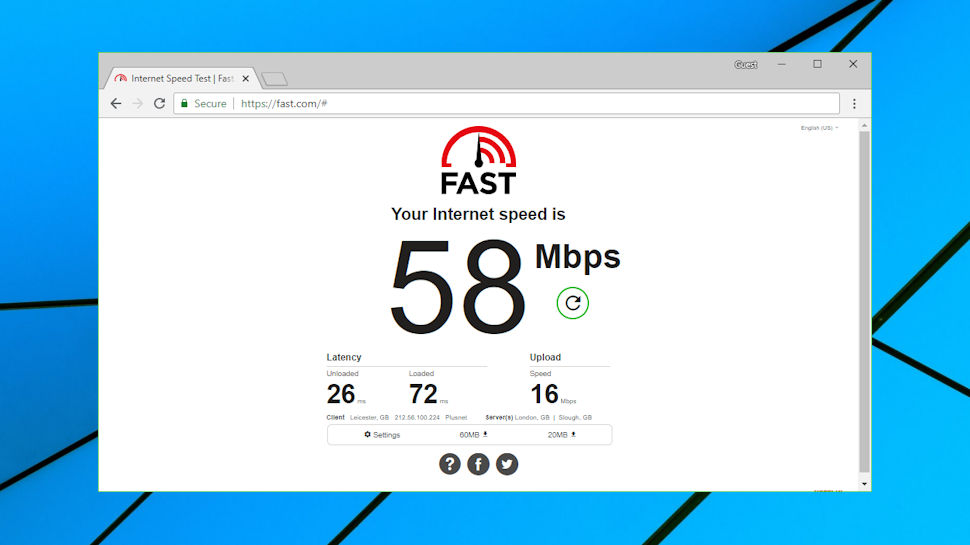
Performance
While privacy features are normally the top priority for a VPN, performance is almost as important. Uncrackable encryption isn't nearly as appealing if it reduces your internet speeds to a crawl, which is why we put all our review VPNs through some intensive performance tests.
Our checks began by connecting to a sample set of 101 NordVPN servers, including 14 in the US and UK, with the others spread around the world. In each case we were looking to confirm that the server was up and how long it took to connect, before running ping tests to check for latency issues, and using geolocation to confirm that the server was where NordVPN claimed it should be. None of these would give us specific information on download speeds, but they're all important factors in the experience of using NordVPN.
These first tests showed an above-average number of connection issues, with 10% of servers failing to connect even after two tries. That's a mild concern, but keep in mind that all VPNs will have connection problems occasionally, and even the best might fail 5% of the time, just down to temporary local or network issues. NordVPN has more servers in distant parts of the world than other services, and that might also increase the chance of connection problems.
Once we were online, though, NordVPN performed very well. Connection times were speedy, latencies were minimal, and every server was in its advertised location.
We ran further speed tests by using Netflix's fast.com to check the performance of four sample location sets: six servers in the UK, eight in the US, 20 across Europe and 19 scattered around Asia, Australia and other more distant locations. It's unwise to trust any single speed test, so we cross-checked our results with openspeedtest.com and speedtest.net. All checks were run on a Windows 10 system via a 75Mbps fiber broadband line.
The results were generally very impressive. Our test connection normally achieved around 72Mbps, and going via a UK VPN barely made any difference, with speeds reaching a very consistent 67-68Mbps. European servers gave us 50-65Mbps, depending on location, and the US also scored well, with east coast locations giving us 60-65Mbps, and even the slowest of our test group managing a very usable 34Mbps.
Switching to our long-distance 'Asia Plus' group finally revealed a few problems, with download speeds becoming less consistent and occasionally dropping to 5-10Mbps in a few locations. But that's to be expected, and even here, most servers performed well, with speeds of 35Mbps available in Australia, 40Mbps in Japan and 45Mbps in South Africa.

Netflix
The ability to access geoblocked websites is a key advantage of any VPN service. NordVPN doesn't explicitly claim to unblock any particular website or service, but statements that it allows you to "keep access to your favorite websites and entertainment content, and forget about censorship" sound good to us.
Measuring a VPN's unblocking abilities is a challenge, especially when it has a network as large as NordVPN, but we've developed an automated test program to help. This can cycle through as many server files as we give it, and we then check whether that location gives us access to US Netflix, US YouTube or (for UK locations) BBC iPlayer.
Unblocking YouTube is as easy a task as you'll get, but we check it anyway to confirm a VPN is doing something useful. And sure enough, NordVPN is, with the site giving us full YouTube access on every one of its servers.
BBC iPlayer is more difficult, as the service makes a real effort to block some proxies and VPNs. NordVPN bypassed this protection in most cases, though, and allowed access to iPlayer with all but one of our eight test locations.
Netflix is usually the biggest challenge, and many VPNs can't unblock it at all, but again, NordVPN had no issues, successfully allowing us in with every server we tried.
That's a very good performance, and although it doesn't prove NordVPN will unblock other websites, its large network and wide range of security, privacy and encryption tricks give you a better than average chance of success.

Torrents
VPNs generally don't shout about their P2P support, and NordVPN is no exception. We had to scroll to the bottom of its web page before we noticed, in tiny print, the words 'P2P allowed'.
Torrents aren't supported on all servers, but the company doesn't restrict you to a couple of options in Amsterdam, either. NordVPN provides hundreds of P2P-friendly servers in the US, UK, and many other locations around the globe. Wherever you are, there should be a suitable server nearby.
VPNs which only support some P2P on some servers can be inconvenient to use, particularly if you connect to a non-P2P server, launch your torrent client and find it doesn't work. But NordVPN is smarter than you might expect, and if it detects P2P activity, it can automatically re-route your connection to a torrent-friendly alternative.
NordVPN points out that it doesn't have any bandwidth limits, so in theory you can download as much as you like. The service small print includes a fair usage-type clause stating that you must not "take any action that imposes or may impose an unreasonable or disproportionately large load on our infrastructure", which might allow the company to take action against very heavy users. But many services have something similar, and we've seen no reason to believe that NordVPN has used this unreasonably.
Along with its direct P2P support, NordVPN has a number of other features which could make it a good torrenting choice: a strict no logging policy, multiple layers of DNS and traffic leak protection, payment via Bitcoin and other cryptocurrencies, and privacy extras including Double VPN and Onion Over VPN.
It's a strong all-round package, although if you're a torrent fan, ExpressVPN is also worth considering. The core features are similar, and while ExpressVPN doesn't have quite as many extras (no Double VPN, for instance), it supports P2P on all its servers and is arguably easier to use.
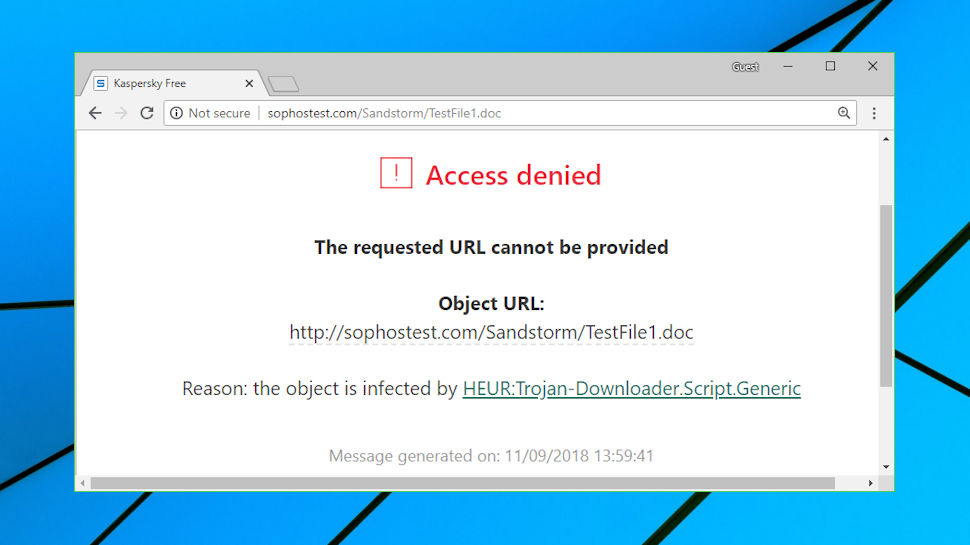
Malware blocking
Connect to a NordVPN server and you automatically benefit from the company's CyberSec feature, a DNS-based blacklisting scheme which blocks ads, phishing and malware sites, and prevents malware on your system accessing known 'command and control' servers.
Properly assessing this kind of URL blocking technology really needs a whole new review of its own, but we set up a small test anyway, just to get a feel for how the service works.
First, we obtained the very latest lists of suspect URLs from website anti-malware service Quttera. These are days, sometimes only hours old, and mostly not yet proven as malicious, so raising the alarm for any of these sites would be an achievement.
To provide a benchmark, we installed Kaspersky Free, then ran a test program which connected to each of our test links in turn. Kaspersky blocked 12 websites from the test set of 510. (As we said, this is a very difficult test).
Next, we disabled Kaspersky, connected to NordVPN and ran our test program again. NordVPN's CyberSec blocked 30 of our suspect URLs. That does suggest it's being kept up-to-date and performing a genuinely useful task, although it's still no substitute for a real antivirus engine. (Kaspersky may have blocked less URLs at the DNS level, but it does far more work analyzing the content, checking file signatures, blocking exploits and generally keeping you safe from harm).
CyberSec also has its issues. User comments on the NordVPN site complain that it sometimes blocks legitimate sites, and the feature doesn't allow you to selectively ignore alerts or whitelist particular sites. If the feature prevents you reaching a site you're sure is safe, the best you can do is turn it off before you visit, and back on when you leave.
The service also aims to block ads. A quick check suggested that it does, to a degree, but not as well as products like uBlock Origin, and again, there's no whitelisting or other options to give you proper control over its actions.
CyberSec does offer some protection, then, but there are also real usability issues, and we suspect most people will be better off with specialist URL filters and ad blockers.

Client setup
Sign up for a VPN and you'll probably want to install a client and try it right away. Some providers make this more difficult than it needs to be, but NordVPN does a very good job. Tap the VPN Apps link, and the website automatically offers you the client download link for the device you're using, presenting you with further links for its other supported platforms: Windows, Mac, Android, iOS, Linux and Android TV.
A lengthy list of more than 80 tutorials explains how to manually set up the service, and includes coverage of many other platforms and device types (Chrome OS, Windows Phone, Raspberry Pi, routers, NAS devices, more).
There's far more detail here than you might expect. NordVPN has no less than 13 Windows tutorials, for instance, covering installing the regular client, OpenVPN, or manual setup guidance for various protocol types on Windows XP, 7, 8 and 10.
It's not all good news. If you're connecting via OpenVPN, you'll want to download the appropriate OVPN configuration files, and as NordVPN has one of these per server, you'll end up with more than 4,000 of these in a single folder.
NordVPN's own tutorials point to why this is a problem, stating that: "OpenVPN GUI... only supports up to 50 configuration files present in the /config/ folder. Thus, you’ll have to copy only a few configuration files to that folder. Since each file represents a server, you’ll have to know beforehand which servers you’ll want to connect to."
The problem here is that the server file names use only two characters to identify the country, which might occasionally leave you wondering (cr1.nordvpn.com.udp1194.ovpn, kr12.nordvpn.com.udp.ovpn). Even when it's obvious, you're left browsing literally hundreds of consecutively-numbered US servers, for instance (us2372.nordvpn.com.udp.ovpn, us2373.nordvpn.com.udp.ovpn, us2374.nordvpn.com.udp.ovpn), with no clear visual cues as to which locations these represent.
When we asked NordVPN how to identify which numbers belonged to which city, they pointed us to a website table listing all locations with their server number ranges, something like this: "Phoenix AZ - 1000-1003, 1074-1081, 1588-1595, 2481-2508, 2541-2552, 377-380, 821-824, 988-999." So 'all' you have to do is scan down a list of 29 cities and perhaps hundreds of ranges until you find yours.
Not exactly convenient, and we would have thought it would be possible to at least improve this by providing more information in the file name. Still, it's not a huge deal. If you use OpenVPN, you'll only have to figure this out once; if you don't, you won't even realize there's an issue.
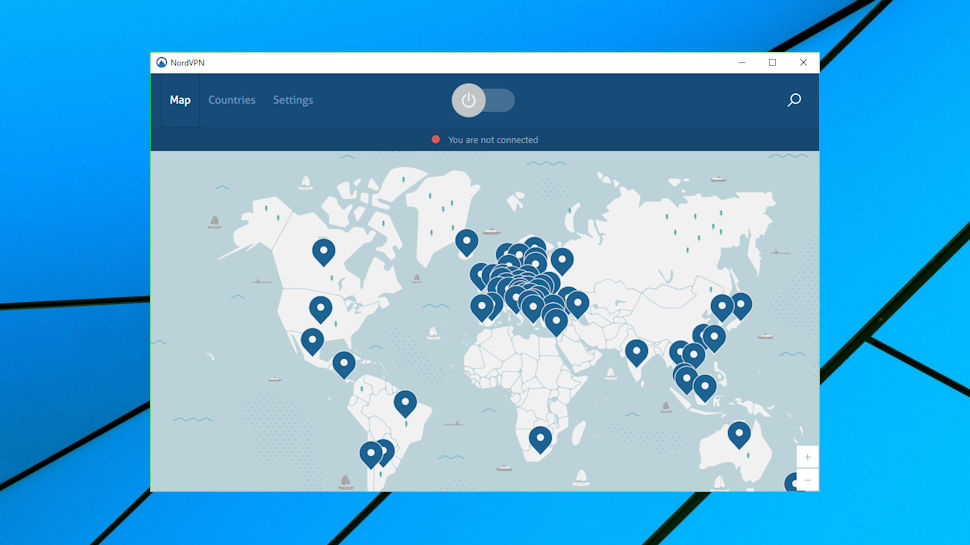
Windows client
NordVPN made it quick and easy to install the Windows client. We visited the download page, it detected our platform, displayed the Windows download link, and we grabbed and installed the software in something under a minute.
The client opens by displaying its many locations on a map. This works much like any other dynamic map you've used – left click and drag to pan around, spin the mouse wheel to zoom, hover your mouse over a highlighted location to see a tooltip of its name – and left clicking any location will connect you to the service.
While this looks good, it's not a very practical system. To access a specific European location, for instance, you'll have to pan to that area of the map, zoom in so that the location marker isn't overlapped by the others, and find your location amongst the others (not everyone will look at a caption-free map and immediately recognize which country is Slovakia, and which is Hungary). Your map location and zoom level are lost when you quit the app, too, so reboot your system and you'll need to start again.

Fortunately, NordVPN also provides a more standard Countries panel with a simple, alphabetically-sorted list of countries. At its most basic, you can scroll to the country you need, click a button and get connected. Very easy.
Tap a More button and NordVPN displays a list of servers and cities within that country (if there's more than one). That's good news for larger countries, as for instance, knowing whether you're connecting to New York or Los Angeles might make a significant difference to performance.
However, there are problems with the way the client implements this. Cities aren't always displayed in alphabetical order, for example, so the US list currently includes sequences like 'Dallas, New York, Atlanta, Seattle, Buffalo...' – forcing you to scan down the list to find what you need.
And if you decide to add a city as a favorite, it's displayed with a server number rather than a city name. We added the fastest Dallas server, for instance, but it appeared on the list as 'United States #1322'. If you add multiple favorites from the same country, this could easily become confusing.
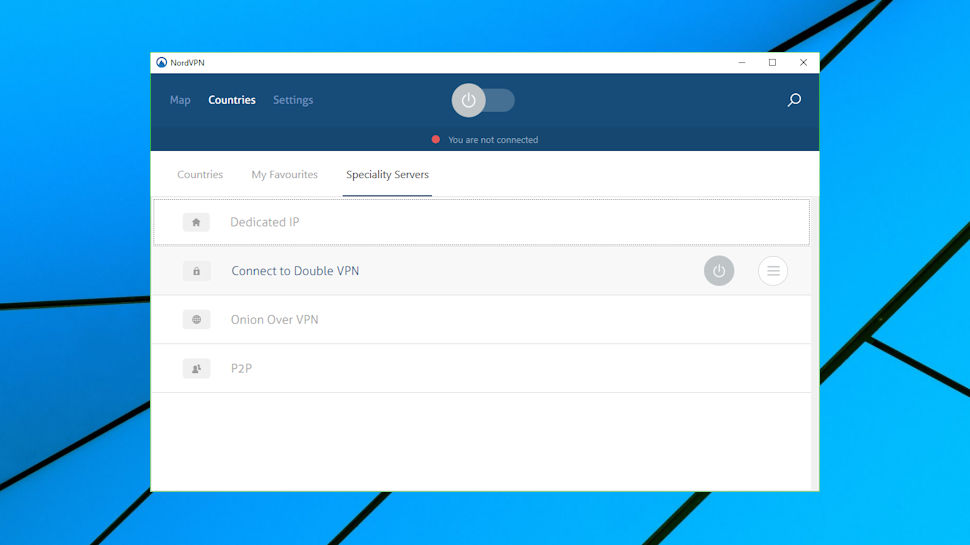
The client also offers a separate Speciality panel, where you can choose servers for a particular task: P2P access, using Onion over VPN, the double encryption of Double VPN, or giving you a dedicated IP. These work much the same as the regular list, so for example you can click P2P and allow the software to choose the fastest server for you, or browse the full set and choose something manually.
If this sounds like hard work, you might have a point. You can add any server to a Favorites list with a click, making it much easier to find later, but poor naming choices mean it's not always obvious what they're for. We added the client's best P2P choice as a favorite, for instance, but it was displayed as 'United Kingdom #488', alongside our other favorites 'United Kingdom #98' and 'United Kingdom #231'. These couldn't be renamed, so we were left to remember which were the best for general use, and which was for P2P.
Once you've figured out the locations you want to use, the rest of the client generally works very well. Tap a server and NordVPN connects within a few seconds. The client interface updates to display your connection status and the location you're using, and even better, a Windows desktop notification tells you when the VPN is turned on and off.
Switching servers is easy, too. If you're connected already, you don't have to close that connection before you can open another. Just click any server and the client will automatically disconnect and reconnect to your choice.
Right click the NordVPN system tray icon and you'll see a list of your recent connections, making it simple to access them again. That could be a real convenience, although it's unfortunate that these aren't also available in the full interface. If a user doesn't think to right click NordVPN's icon, they'll never realize the recent connections are available at all.
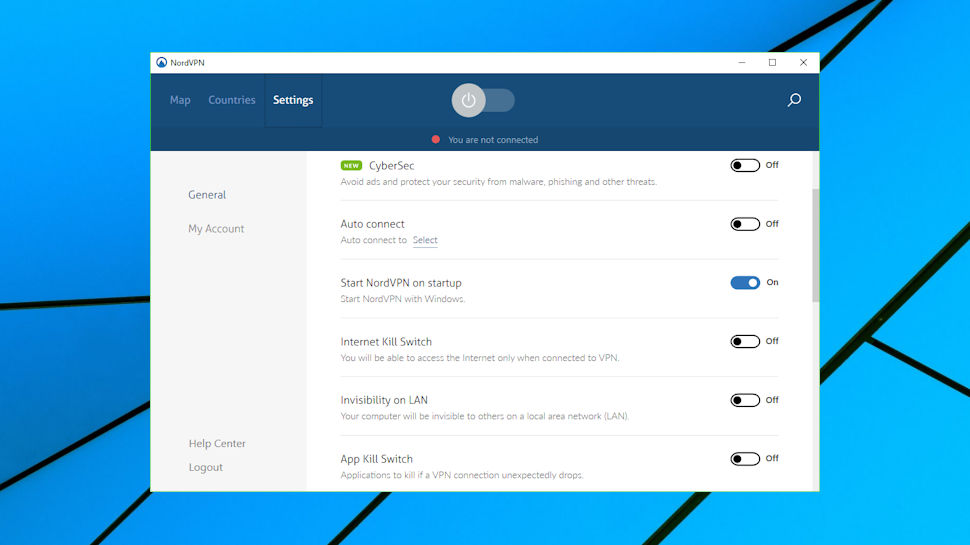
Elsewhere, an interesting Settings dialog has some unusual plus points. It doesn't just allow you to launch NordVPN on startup, for example. You can also have the client automatically connect to your most commonly-used server, every time it launches, avoiding any hassles from the client's usual selection process.
NordVPN's kill switch (a system to avoid data leaks if the VPN connection drops) also offers more control than most. An internet kill switch blocks all access to the internet unless you're connected to the VPN, while a separate app kill switch closes particular apps if the VPN drops (your torrent app, for instance).
Protocol support is limited, at least with the Windows client. You can toggle between OpenVPN TCP and UDP only, and even that is hidden away in an Advanced Settings panel.
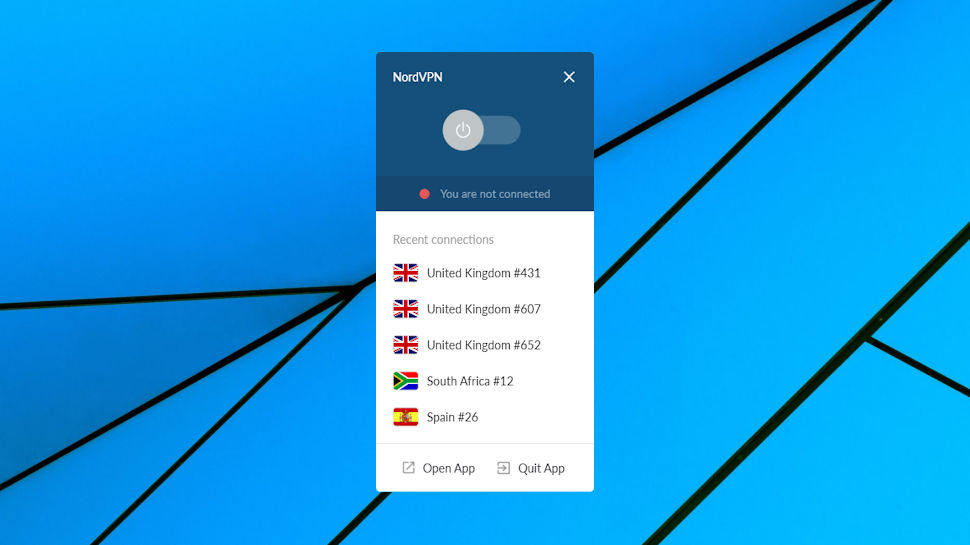
By way of compensation, NordVPN provides the option to set your preferred DNS for all VPN connections. Most users should probably leave this alone, but if you know what you're doing, replacing the DNS could improve browsing performance, help to block access to malicious websites, or add other benefits.
Put it all together, and although NordVPN's Windows client has some issues, it's generally well-presented and easy to use. Once you're over any initial setup hassles, it's a comfortable place to view and control your VPN status.

Android app
The NordVPN Android app is one of the most popular around, with more than five million downloads, and a very impressive 4.3 rating on Google Play (even ExpressVPN only manages 4.1).
While we never assume that app store ratings are accurate, we've also regularly seen VPN apps get 1-star reviews for no good reason, as users blame them for many other network and internet issues. To rate 4.3 is a real achievement, for sure.
Setup follows much the same route as any other service. Click Install, the app downloads, and you can launch it with a tap.
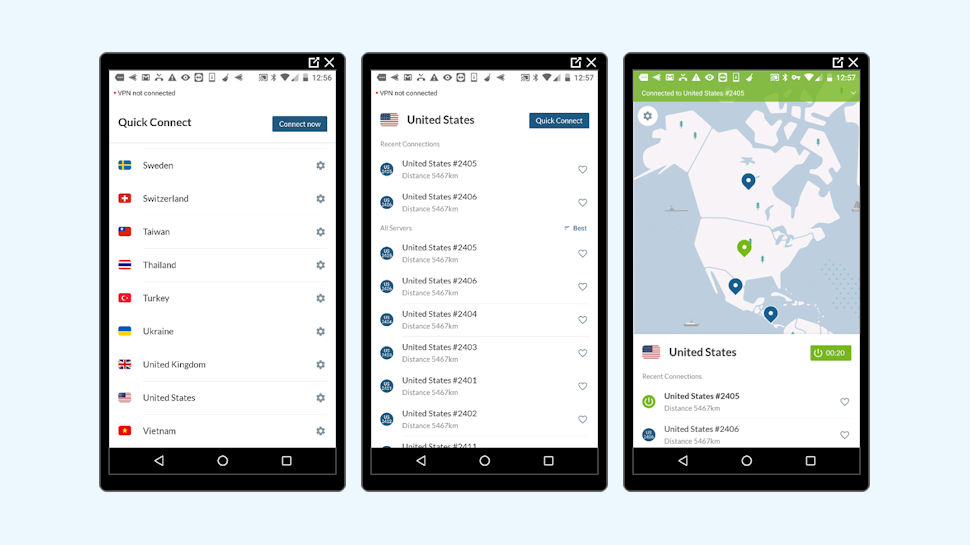
The app opens with the top part of the screen displaying your available locations on a world map, the lower part being reserved for a server list. You already know the basic operating principles here, as they're the same as any other map you've ever used: pinch to zoom in on the area with the location you need, drag to pan around, tap a location marker to connect to it. But it's just not very practical.
You might have to zoom in a long way to see the area you need. Do that on Europe, say, and you could be faced with 40 location markers but no text captions, so if you want to choose Macedonia, you'll need to know where it is on the map.

And switching somewhere else in the world might require zooming out, panning around and zooming in somewhere else. While this isn't difficult, you're still spending more time navigating the app interface than we would like.
Fortunately, and just like the Windows client, NordVPN's Android app also supports a conventional countries list. Swiping up gets you an alphabetical list of countries, and you can scroll down to the US (or anywhere else), tap it, and immediately get connected to the best server in that country.
The NordVPN app uses the standard OpenVPN for Android software layer to make and manage your VPN connection, and that's a smart move. Users don't have to hope that NordVPN can produce the code to make its VPN connections correctly, because it’s already using a known, trusted and reliable product which can do exactly that.
If you need more control over your location choice, tapping a Menu button displays the full list of servers in that country. It improves on the Windows client by displaying your recently-connected servers from that country, too, so if you've found a server which unblocks Netflix, for instance, you can reconnect to it in seconds.
What you don't get with the Android app is any form of server load information. The Windows client provides a "percentage loaded" figure, but all you get with the app is a "distance from your location", and even that is based on the country, rather than the actual server location (so all US servers will be displayed with the same distance).
As usual with mobile software, the Android app also has fewer settings than its desktop cousins. In particular, there's no kill switch and no option to choose your own DNS servers.
What you do get is get malicious IP blocking via NordVPN's CyberSec, and a smarter auto-connect exclusion option. For example, you could set up the app to automatically connect on all Wi-Fi hotspots apart from your home and other trusted locations, ensuring you only turn on the VPN when you know you need it.
The app isn't quite perfect, then, and we're not sure the map element of the interface adds a lot. But otherwise it's a likeable and capable application which outperforms most of the competition.

iOS app
The NordVPN iOS app installed easily and with precisely zero surprises. Find it in the app store, install, open, log in and you're ready to go.
The app opens with the same slightly awkward map interface as the other clients, although the iOS developer has done a marginally better job of implementing it. You can't zoom out as far as the Android app allows, which means the individual location markers are never left overlapping and hiding each other. And when the map is displayed, the lower panel reduces to just enough space for a Quick Connect button, leaving the maximum screen real-estate for map details.
We still think a map isn't the best way to switch between locations, although if you agree, swiping up displays the regular country list. Here you can connect to any country with a tap, or choose individual regions and servers if you prefer.

Interestingly, the iOS app is the only client we tried which enables choosing servers by region. The Android and Windows apps displayed the servers within a country using only numbers, but on iOS you're able to directly choose a US server in Chicago, Denver, Los Angeles, New York, San Francisco and many other cities. That's exactly how it should be, and hopefully NordVPN will update its other clients to work in the same way.
It's not all good news, though, and unfortunately the iOS Speciality Server list is a little shorter than the others. You can view and select servers optimized for P2P or that support Onion over VPN, but there's no Double VPN or Dedicated IP option. That's not a huge deal and the Double VPN feature won't be necessary for most users, anyway, but if NordVPN is trying to sell itself on that kind of extra, we'd like to see it available on all clients.
The iOS app's Settings panel is also relatively basic. The good news is it has a kill Switch which disconnects you from the internet if the VPN goes down, a welcome privacy plus. But you don't get the malicious IP filtering CyberSec, the TCP or UDP protocol control, auto-connection or the Obfuscated Servers feature (handy for getting online with countries with restrict the use of VPNs).
That isn't entirely NordVPN's fault – Apple's security model places strict limits on what apps can do – but it's something to keep in mind if you'll be mostly using the VPN on your iPhone.

Browser extensions
VPN clients are generally easy to use, but getting yourself connected can still take a little work. If you need to unblock a website on your Windows laptop, for instance, you might have to click to display your system tray icons, click again to display the client, click the Countries tab, expand the full list of servers, click your preferred option, wait to see when you're connected, and finally Alt+Tab back to your browser.
NordVPN offers Chrome and Firefox proxy extensions which can simplify this process by allowing you to choose a VPN location, then connect and disconnect directly from the browser window.
Installing the Chrome extension added a NordVPN icon to our system tray. We tapped this and logged in to the service when prompted.
The extension interface doesn't have the map you'll see in the clients, but that's no great loss. Instead you're presented with an Auto Connect button which connects you to the fastest server, and a Choose Location option which enables selecting a particular country only. (There's no ability to choose a particular server within a country; NordVPN will decide that for you).
A small Settings dialog allows you to block WebRTC leaks in Chrome, reducing privacy risks, and you can also enable or disable the malicious website-blocking CyberSec feature.
We checked out NordVPN's Firefox extension to look for any differences. The interface and functionality was the same as the Chrome add-on, but the Firefox version seemed far less responsive, with around a two second delay before responding to any command. This was annoying, but we were unable to find the cause, so it's possible this was a local issue that wouldn't necessarily be repeated on other systems.
Overall, this isn't as capable a setup as you'll see with some of the competition. ExpressVPN's browser extensions control and work with the full ExpressVPN client, so once you enable them within your browser, they protect your entire system. The NordVPN extensions are simple proxies, and protect your browser alone.
Still, the proxy approach is perfect for simple website unblocking, connections are much faster, and using NordVPN within a browser could be useful in a few situations (some of your apps don't work with a VPN, for instance, or the VPN reduces your system performance). We're happy that NordVPN offers browser extensions at all – most VPN providers don't – and overall, it's a plus point for the service.

Support
VPNs can be a highly technical topic, and every good provider should be able to offer expert assistance whenever you need it.
NordVPN's first line of defense is its support website. Articles are sorted into sensible categories (Getting Started, Connectivity, Billing, General Info), and a search box allows you to find articles by keyword.
The knowledgebase isn't bad, and there is some useful information here. Type Speed into the search box, for instance, and the website displays a 'Speed and Bandwidth' article with plenty of relevant tips (restart devices and routers, try another location, another network, change your protocol settings, and more).
Articles tend to be short, though, and there aren't as many as we would like. Organization isn't great, either. We would expect the Getting Started section to have installation guides highlighted, but the first list doesn't include any at all. This is bizarre, because NordVPN does have a lot of quality setup tutorials, they're just not apparently linked or searchable from the help knowledgebase.
The NordVPN site also fails to mention any other help resources. ExpressVPN's support page includes links to launch live chat, open a support ticket or send an email to the support team, for instance. NordVPN's page doesn't even tell you which of these options are available.
This might partly be because NordVPN doesn't have many other options. The company used to have live chat support, but that doesn't seem to be available any more. There's no ticket system, just a support email address, which the website warns has a response time of 'up to 48 hours'. That's not good, even by email support standards, and we've had useful first responses via ExpressVPN's live chat in around two minutes.
Still, it seems like the '48 hours' warning was a worst case scenario. We sent a test email at 9:29pm and had a helpful reply at 9:10am the following morning. That's not great, but it's comparable with many other VPNs, and the response we received was accurate and detailed enough to solve our problem.
Final verdict
An appealing VPN which is fast and (mostly) user-friendly. It's let down a little by the awkward map-based interface and occasional connection issues, but overall, it's a likeable service which will deliver for most users.
- Also check out the best VPN services
0 comments:
Post a Comment